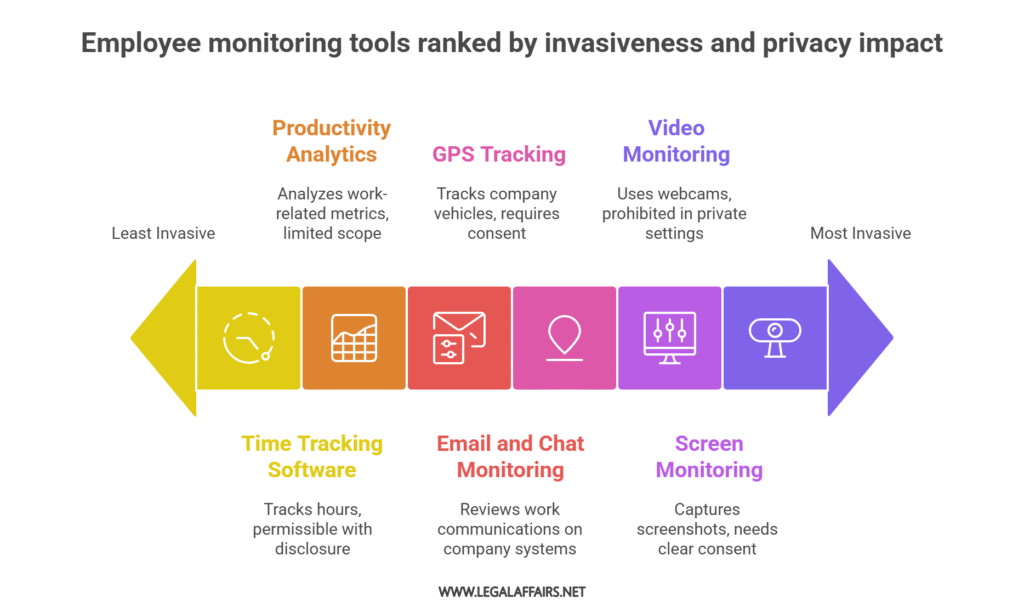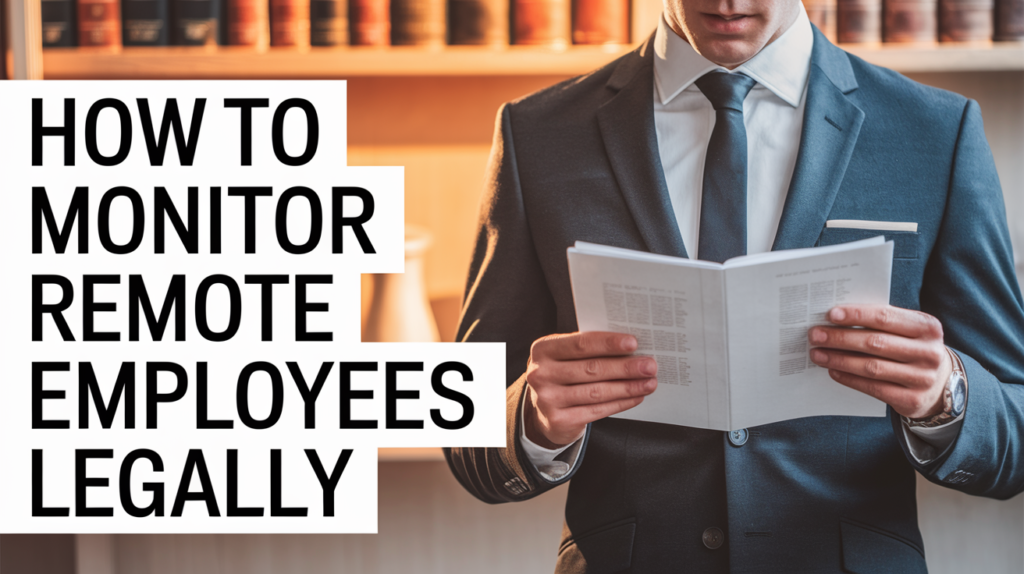Are you struggling to keep track of your remote team’s productivity? You’re not alone.
As more businesses embrace the remote work model, the challenge of monitoring employees effectively—and legally—has become a pressing concern. You want to ensure your team is performing at their best, but you also need to respect their privacy and stay within legal boundaries.
This is a delicate balance that many managers grapple with. You’ll discover practical and lawful strategies to monitor your remote workforce. These tips will not only help you boost productivity but also build trust and transparency with your team. Ready to transform your remote management approach? Let’s dive in and uncover how you can achieve this balance seamlessly.
Why Monitor Remote Employees?
Remote work has become a huge part of our lives, especially since the COVID-19 pandemic. In fact, about 30% of jobs in the U.S. are now remote. Why do companies watch over their remote teams? Here’s the scoop:
-
Productivity and Accountability: Make sure everyone is getting their work done.
-
Data Protection: Keep company secrets safe.
-
Regulations Compliance: Follow industry rules, like HIPAA for healthcare.
-
Prevent Misconduct: Stop things like time theft or unauthorized data sharing.
But here’s the catch. Monitoring has to follow the law. If not, it could lead to lawsuits, fines, or even lose the trust of your workers. Bad monitoring? It can break privacy laws. The result? Penalties or a bad reputation.
Legal Framework for Monitoring Remote Employees
The U.S. has a bunch of laws about workplace monitoring. They try to strike a balance between what bosses can do and the privacy of workers. Let’s break it down:
-
Electronic Communications Privacy Act (ECPA): Don’t spy on emails or calls without permission. But… If workers use company gadgets, monitoring is usually okay.
-
National Labor Relations Act (NLRA): Workers can talk about work conditions. Even in monitored emails or chats. But, if monitoring stops them from unionizing? That’s a no-go.
-
State Privacy Laws:
-
California: You need to tell and get permission before monitoring.
-
Connecticut and Delaware: Give workers a heads up about electronic monitoring.
-
New York: Written notice is a must for monitoring emails, internet, or phones.
-
Others: Illinois and Texas are big on consent before recording calls or video.
-
-
Fourth Amendment (Public Sector): Public workers have some privacy rights. Monitoring should be work-related and reasonable.
-
Common Law Privacy Torts: Be careful. If monitoring is too nosy, like checking personal accounts, you might face privacy claims.
-
Industry-Specific Laws: In healthcare and finance, laws like HIPAA and GLBA add extra layers of data protection.
Keeping it simple? Think of it like this. Monitoring is like walking a tightrope. Do it right, and you balance productivity and privacy. Mess it up, and you might fall into legal trouble.
Types Of Monitoring Tools
Monitoring remote employees legally is crucial for businesses. Choosing the right tools helps track productivity, manage workloads, and ensure compliance. There are various types of monitoring tools available. Each serves a different purpose and offers unique features. Understanding these tools can help you make informed decisions.

Time Tracking Software
Time tracking software records the hours employees work. It provides insights into how time is spent. This tool helps ensure employees are working their scheduled hours. It also aids in accurate payroll management. Many time tracking tools offer features like automatic time logging. They can integrate with other business tools for seamless operation.
Productivity Analysis
Productivity analysis tools help assess employee efficiency. They track tasks completed and time taken. These tools identify patterns that affect productivity. By analyzing data, managers can find areas for improvement. Tools may include dashboards for visual insights. They support goal-setting and performance reviews.
Communication Monitoring
Communication monitoring tools keep track of employee interactions. They record emails, chats, and calls. This ensures compliance with company policies. Such tools can prevent data breaches or inappropriate behavior. They often come with alert systems for suspicious activities. Communication monitoring is vital for maintaining workplace integrity.
Implementing Monitoring Policies
Implementing monitoring policies ensures legal remote employee oversight. Clear guidelines protect privacy while maintaining productivity. Transparent communication builds trust.
Implementing monitoring policies for remote employees can be a delicate task, blending the need for oversight with respect for privacy. The goal is to create a balanced approach that ensures productivity while fostering trust. It’s not just about setting rules; it’s about engaging your team in a conversation about expectations and boundaries. Let’s explore some effective ways to implement these policies.
Clear Communication
Open and honest communication is the backbone of any effective monitoring policy. Start by explaining why monitoring is necessary. Is it to ensure productivity, protect company data, or both? Involve your employees in this conversation. Ask for their input and address their concerns. This shows that you value their perspective and fosters a sense of ownership. Establish clear guidelines on what will be monitored and how the information will be used. Transparency helps in minimizing misunderstandings and builds trust.
Employee Training
Training is key to successful policy implementation. Equip your employees with the knowledge they need to understand the monitoring tools and techniques. Offer workshops or webinars that explain how the monitoring process works. This can demystify the technology and alleviate fears about privacy breaches. Provide continuous support and resources. Encourage your team to ask questions and seek clarification when needed. A well-informed team is more likely to embrace the policies positively. By focusing on communication and training, you create a culture of trust and collaboration. How can you ensure that your monitoring policies are both effective and respectful? Engage with your team and keep the conversation going.
Balancing Trust And Accountability
Legally monitoring remote employees requires balancing trust and accountability. Establish clear policies that respect privacy while ensuring productivity. Use transparent tools and communicate openly to maintain a positive work environment.
Balancing trust and accountability is crucial in remote work settings. Employers need to monitor employees, but they must do it legally. They must also maintain trust. Finding this balance can be challenging. Yet, it is necessary for a productive work environment.
Building A Culture Of Trust
Creating a culture of trust starts with clear communication. Employers should explain why monitoring is needed. Transparency is key. Employees need to understand the benefits. They must feel valued and respected. This approach fosters trust. Encourage open dialogue. Invite feedback from employees. This makes them feel heard. It also builds mutual respect. Trust strengthens when employees know their voices matter.
Ensuring Fairness
Fairness in monitoring practices is essential. Every employee should be treated equally. Monitoring tools should be applied consistently. This prevents feelings of unfair treatment. Ensure that the data collected is relevant. Only gather what is necessary for work performance. Excessive monitoring can damage trust. Stick to what is essential. Regularly review your monitoring policies. Adjust them as needed. This ensures they remain fair and effective. Employees appreciate fairness. It boosts morale and productivity.

Addressing Employee Concerns
Monitoring remote employees can be a touchy subject. You want to ensure productivity, but also respect their privacy. Addressing employee concerns is crucial in creating a balanced approach. If you don’t, you risk alienating your team and losing their trust. How can you make monitoring feel less intrusive and more collaborative?
Feedback Channels
Encouraging open communication is key. Establish feedback channels where employees can express their worries. Use surveys or regular check-ins to gather opinions.
Be transparent about why monitoring is necessary. Explain how it benefits both the company and them. When employees see the bigger picture, they are likely to feel more comfortable.
Think back to a time when you felt micromanaged. How did it affect your performance? Use this experience to create a system where employees feel heard and valued.
Regular Policy Reviews
Policies can quickly become outdated. Regularly review your monitoring policies to ensure they remain relevant and fair. Involve employees in this process.
Create a simple guideline document that everyone can understand. Use clear language and bullet points for easy reading. This helps avoid misunderstandings and keeps everyone on the same page.
Ask yourself: Are your policies respecting employee privacy? Adjust them based on feedback and technological changes. This shows your team that their concerns matter.
By addressing employee concerns, you’re not just monitoring their activities; you’re fostering a culture of trust and openness. How you approach this could define your team’s success and satisfaction.
Evaluating Monitoring Effectiveness
Monitoring remote employees legally is crucial for businesses. It ensures productivity and compliance. Evaluating the effectiveness of monitoring practices is vital. It helps businesses understand what works and what doesn’t. This evaluation can improve overall employee management. Let’s explore key aspects of this evaluation.
Performance Metrics
Performance metrics are essential in monitoring effectiveness. These metrics show how well employees meet goals. They include task completion rates and quality of work. Time spent on tasks is another key metric. These indicators provide a clear view of employee productivity. Regularly reviewing these metrics helps identify trends. It shows where improvements are needed.
Adapting Strategies
Adapting strategies is crucial for effective monitoring. Businesses must be flexible in their approach. Monitoring methods should evolve with technology changes. Employee feedback can guide strategy adjustments. Consider new software tools for better monitoring. Tailor strategies to fit company goals and employee needs. This ensures monitoring stays relevant and effective.
Pros of Keeping an Eye on Remote Workers
Let’s talk about why some companies monitor their remote teams. Here’s the scoop:
- Better Productivity: It’s like having a map. It shows you where things are working and where they’re not. A study in 2023 said using monitoring software can boost productivity by 20%.
- Data Safety: Keeps your company’s secrets safe from leaks.
- Following Rules: Helps companies stick to industry rules. Think of financial firms and their need to follow FINRA.
- Accountability: Makes sure remote workers are hitting their targets.
Cons of Watching Over Remote Employees
But hey, it’s not all sunshine and rainbows. There are some downsides too:
- Privacy Worries: Some folks feel like it’s too much. A Gallup poll from 2024 found 64% of employees felt uneasy about being watched.
- Legal Trouble: Messing up with laws like ECPA can cost big time. Think fines over $50,000.
- Morale Hit: Too much watching can make people unhappy at work. And then they leave.
- Cost of Set-Up: It can be pricey. Software and making sure you’re following the rules can run anywhere from $500 to $10,000 a year. Depends on the company size.
Handy Tips for Employers
So, you’re thinking about monitoring? Here are some tips:
- Be Open: Talk about it. Let your team know what’s up during onboarding and remind them often. Keep it simple.
- Keep It Simple: Focus on work stuff. Like project milestones. Avoid creepy things like constant webcam checks.
- Pick Good Software: Go for trusted tools like ActivTrak or Veriato. They offer compliance and encryption.
- Get Legal Help: An employment lawyer can help make sure your policies are legal, especially across different states.
- Mix Monitoring with Trust: Combine it with regular check-ins and performance reviews. Builds a healthy work culture.
- Be Flexible: Understand remote work challenges. Things like flexible hours or caregiving roles matter when looking at productivity.
- Document Everything: Keep records of consent forms, notices, and policy updates. It’ll help if legal issues pop up.
State-Specific Advice
If your team is spread across different states, here’s what you need to know:
- California: Needs clear consent for any recording or monitoring. Check out Cal. Penal Code § 632. Plus, CCPA requires data privacy notices.
- New York: You need to give written notice before monitoring. See N.Y. Lab. Law § 52-c.
- Illinois: Both parties need to agree to audio/video recordings (720 ILCS 5/14-2).
- Texas: One-party consent for recordings is okay, but privacy laws still apply.
- For Multi-State Employers: Follow the strictest state laws if your team works across borders.
Frequently Asked Questions
How Can I Monitor Remote Employees Legally?
To monitor remote employees legally, you must comply with privacy laws and regulations. Inform employees about monitoring practices and obtain their consent. Use transparent communication to explain the purpose of monitoring. Choose software tools that respect privacy and data protection standards.
Regularly review and update your monitoring policies.
What Are The Best Tools For Employee Monitoring?
The best tools for employee monitoring include Time Doctor, Hubstaff, and Teramind. These tools offer features like time tracking, productivity analysis, and activity monitoring. They ensure compliance with privacy regulations. Choose a tool that aligns with your business needs and respects employee privacy.
Always inform employees about the tools used.
Is It Ethical To Monitor Remote Employees?
Yes, it is ethical if done transparently and with consent. Ensure employees are aware of monitoring activities and understand their purpose. Use monitoring to improve productivity, not to micromanage. Respect privacy by minimizing intrusive practices. Maintain open communication to build trust and address any concerns about monitoring.
How Do I Inform Employees About Monitoring?
Inform employees through clear communication, preferably in writing. Explain the reasons for monitoring and its benefits. Detail what data will be collected and how it will be used. Obtain their consent before implementing any monitoring tools. Regularly update employees on any changes to monitoring policies to maintain transparency.
Conclusion
Monitoring remote employees legally is essential. It builds trust. Boosts productivity. Create clear policies. Communicate openly with your team. Use technology responsibly. Respect privacy at all times. Avoid invasive methods. Choose tools wisely. Educate employees about monitoring practices. Encourage feedback.
Stay informed about legal requirements. Regularly review your approach. Protect your business and your employees. Strive for transparency and fairness. Adapt as laws change. Keep communication open. It’s about balance. Protecting interests without compromising ethics. Maintain a respectful workplace. Ensure everyone feels valued and secure.
That’s key to successful remote monitoring.
References
- Electronic Communications Privacy Act, 18 U.S.C. § 2510 et seq. (2025).
- National Labor Relations Act, 29 U.S.C. § 151 et seq. (2025).
- California Consumer Privacy Act, Cal. Civ. Code § 1798.100 (2025).
- California Invasion of Privacy Act, Cal. Penal Code § 630 (2025).
- Conn. Gen. Stat. § 31-48d (2025).
- Del. Code Ann. tit. 19, § 705 (2025).
- N.Y. Lab. Law § 52-c (2025).
- O’Connor v. Ortega, 480 U.S. 709 (1987).
- Katz v. United States, 389 U.S. 347 (1967).
- Health Insurance Portability and Accountability Act, 45 C.F.R. § 164 (2025).
- Gramm-Leach-Bliley Act, 15 U.S.C. § 6801 (2025).
Disclaimer: The content on this page is for general information only and should not be considered legal advice. We work hard to provide accurate and up-to-date details, but we can't guarantee the completeness or accuracy of the information. Laws and rules change often, and interpretations may vary. For specific advice, always consult a qualified legal expert. We are not liable for any actions you take based on this information. If you spot any errors or outdated content, please contact us, and we’ll update it as soon as possible.


